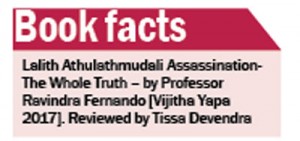A search for truth in muddied waters
View(s): Professor Ravindra Fernando has carved a niche for himself as the foremost medico-legal writer on sensational murder cases in Sri Lanka. His writings on the Wijedasa Liyanarachchi killing, the unsolved Sathasivam Case and the sensational Murders at the Vicarage have enthralled the reader with their fascinating mix of social history, character studies, forensic expertise and legal authority.
Professor Ravindra Fernando has carved a niche for himself as the foremost medico-legal writer on sensational murder cases in Sri Lanka. His writings on the Wijedasa Liyanarachchi killing, the unsolved Sathasivam Case and the sensational Murders at the Vicarage have enthralled the reader with their fascinating mix of social history, character studies, forensic expertise and legal authority.
In his latest book he boldly wades into the murky waters of a sensational political assassination that stunned Sri Lanka in that year of tragedies 1993. Shakespeare would have crafted a great tragedy of this assassination that took place on the Bard‚Äôs birthday ‚ÄďApril 23. On this day, Lalith Athulathmudali, a rising star in our political firmament, was shot dead in cold blood. This tragic event yet reverberates in the nation‚Äôs memory giving rise to many theories as to who, how and why this assassination took place.
Although President Kennedy‚Äôs assassination took place over half a century ago, and the Warner Commission pronounced its findings, there has been no end to the wild theories regarding this event. This is, perhaps, inevitable ‚Äď as in the case of¬† Athulathmudali ‚Äď when a famous political leader is killed. Professor Fernando has now produced a meticulously researched study into the shooting, the Police investigations and the subsequent judicial proceedings.
The author begins with an outline of Lalith‚Äôs brilliant academic and political career but he tip-toes diplomatically over the bitter political rivalry that wanted to eliminate him from the political stage. His account of the shooting brings into play a strange and disturbing cast of characters. Among these are the mystery officials who switched off all the street lights before the fateful meeting, Tilak Shanta, Athulathmudali‚Äôs¬† bodyguard of dubious antecedents,the volunteer witness¬† Wijegunawardena who¬† went to meetings because he liked to see politicians, Janaka Jayamanne, an underworld suspect, the unidentified body at Mugalan Road, Lingeswaran, the alleged killer‚Äôs LTTE ‚Äėminder‚Äô, the Police officers who, strangely, never saw the body at Mugalan Road.
The Police investigation is presented in detail as well as the deliberately confusing statements made by key witnesses and the disappearance of vital items. By this stage President Premadasa, who had his ear to the ground, had become aware that fingers were pointed at him as the perpetrator, and beneficiary, of the assassination. With characteristic shrewdness he decided to deflect these suspicions by requesting the British Government to support the Police investigation with a team from Scotland Yard. He was confident that their objective investigation would absolve him of complicity.
The Scotland Yard Polce Officers and medical experts inspected the scene of the crime and the bodies of Athulathmudali and the ‚ÄúMugalan Road Man‚ÄĚ.¬† Their report, though meticulous is, inevitably, devoid of the human motivations behind the crime. The record of our Police investigation, though evidently ‚Äúcorrect‚ÄĚ, seems riddled with gaps and inconsistencies, One can hardly believe that their search of the crime scene did not notice the body sprawled by the blood spattered wall of the¬† Mugalan Road Co-op . Nor the inexplicable disappearance of Lalith‚Äôs bodyguard, noted for fictional statements, from hospital custody. Meanwhile, a shady¬† character, Lingeswaran, was arrested on suspicion that he was involved in the murder. Strangely, he remained in custody till 2002 when he was released to the LTTE at their request, during the abortive Ceasefire.Yet another mystery.

The author speaking at the launch
President Premadasa was assassinated a week after Lalith Athulathmudali. After the brief Presidency of D.B.Wijetunga and the assassination of¬† Athulathmudali‚Äôs colleague and rival Gamini Dissanayaka, the next Presidential Election brought into power Chandrika Bandaranike Kumaratunga [CBK]. Her husband Vijaya, the film star politician, was also assassinated during that ‚Äúannus horribilis‚ÄĚ. There was no love lost between CBK and the remnants of the Premadasa ‚Äėgang‚Äô. She was, probably genuinely , convinced that Premadasa masterminded Athulathmudali‚Äôs killing, she then appointed a Special Presidential Commission of Inquiry [SPC] into his assassination ‚Äúwhereas numerous allegations have been made that the investigation‚Ķ..was not conducted in a proper and impartial manner.‚ÄĚ
The proceedings of this SPC, headed by retired Judges, makes depressing reading.¬† It is fairly obvious they strained hard to link the President, via his minions, with the killing. Their vain attempt to implicate¬† Sirisena Cooray, Premadasa‚Äôs¬† trusted right hand man, is sheer black comedy. The blind determination of the SPC to ‚Äúfulfil its contract‚ÄĚ (to put it crudely) can be seen in their summing up . ‚ÄúThe Commission is of the view that President Premadasa himself was directly involved in the conspiracy to assassinate Athulathmudali and that others did his bidding.‚ÄĚ
In the course of its proceedings the SPC also proceeded to accuse eight Police Officers of being involved in the killing.¬† This was so bad in law that the Supreme Court quashed these ‚Äúfindings‚ÄĚ and exonerated these upright officers whose careers had been in jeopardy.
The author‚Äôs conclusion is that it is crystal clear that Lalith was shot dead by the man whose body was found in Mugalan Road. But that, I am afraid, is not the ‚Äúwhole truth‚ÄĚ. I firmly believe what Eric Ambler, master of espionage fiction, said about an assassination in his masterpiece The Mask of Dimitrios ‚Äúit is not the finger on the trigger that kills but he who pays for the bullet‚ÄĚ. As such, the author‚Äôs sub-title The Whole Truth should, therefore, end not with a full stop, but with a question mark.
It is an immensely gripping narrative and a window into a dark period of Sri Lanka’s recent political history.



